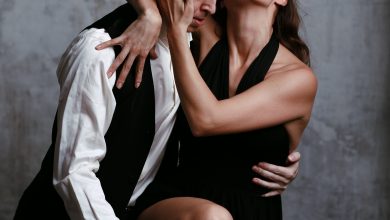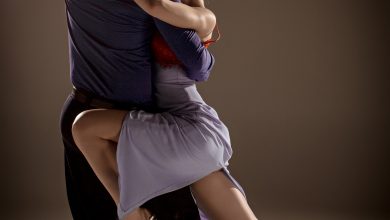Paradas (Stop) and Pasadas (Stepovers)

The parada (or stop) is a move that is considered unique to tango as it is not found in other dances. The leader places one foot against the follower’s foot indicating that they should stop and wait for the leader’s next move. There are a variety of situations where this Parada can be done, including the choice of which foot, and the choice of which side of the feet to use.
A Pasada (or stepover) frequently follows the Parada. In the Pasada, the follower steps over the leader’s foot which made the Parada. The two most common Parada and Pasada sequences at the beginner level are from a Front Ocho and from a Back Ocho.
When leading the Front Ocho, the leader places an unweighted foot against some part of the foot the woman is pivoting on and uses their upper body, frame and hand to stop the follower at the completion of the pivot – ie before the follower takes their next step. The leader will pause the follower at this point before then leading a stepover (pasada). This can be done on either the open or closed side of the leader’s body.
From the Back Ocho the Parada and Pasada combination can be performed by using a move known as the sandwich. The Back Ocho followed by Parada can be performed on either the open or the closed side.
Here is a description of the Parada on the closed side. Immediately after the follower has stepped back with their right foot and before the follower has any chance to move their left foot, the leader paradas the outside of the follower’s left foot with the inside of their right foot effectively blocking the follower’s left foot from making any kind of movement. Next the leader sandwiches the follower’s left foot by bringing his left foot to the immediately left of the follower’s left foot so that the follower’s left foot is sandwiched between the leader’s two feet. The leader then steps back with their right foot causing the follower to step forward with their right foot and bringing the follower’s weight and axis fully onto their left foot. At the same time, the leader turns their chest a little to the left which opens a path for the leader to lead the follower into a stepover with their right foot.
Some important points to remember when leading the Parada and Pasada:
- The foot placement right next to the follower’s foot is just one part of the lead. The leader must also lead the follower to stop with their upper body embrace.
- The leader’s foot should merely be placed. No weight should be transferred to it. The leader’s foot doing the parada should be unweighted. The leader must also place his foot right next to the follower’s foot so it’s presence is felt by the follower. Without this touch, the follower really has no way of knowing that the leader is performing a Parada.
- There is a lot of choice in where the leader places their foot relative to the follower’s foot. Some leaders reach way over the follower’s foot, some make a barrier in front, some place a toe against the ball of the foot, and some parada in the back of the foot.
One final but very important additional component of the Parada that is optional but highly encouraged is the Adorno (or Embellishment).
As described above, the leader should pause upon completion of the Parada before starting the Pasada. The leader can hold this pause inviting and encouraging the follow to add an embellishment (Adorno). Most followers will do a little something as an embellishment. The Leader should be sensitive to the timing of the pasada to let the follower complete their adorno. The leader should not rush the follower out of their embellishment. The follower can of course choose not to embellish.
Unless you know the follower can handle unusual combinations, use only simple parade / pasada combinations. There are many possibilities, eg the leader can use either the inside or outside of either the left or right foot against the inside or outside (or toe or heel) of the left or the right follower’s foot. Many of these do not lead naturally to a simple pasada, but perhaps to a back pasada or barrida. And some are just awkward. But you might enjoy trying to figure out which work for you.
Here are some videos to watch that demonstrate the Parada, Pasada and embellishments:
By the 8th Style School of Tango. A short demonstration of repeating Paradas and Pasadas with front ochos.
Tango Lesson: Paradas and Pasadas from the Forward Ocho
By Homer Ladas and Diane Yoon.
Tango Elements: walk to the parada
By Los Angeles Tango Academy. Nice video showing a parada from walking followed by a pasada (stepover).
Argentine Tango lesson – Ochos And Parada
By Ross Todorovic. Most of the video is about ochos, but there is a parade and sandwich in a back ocho.
Pasadas and Paradas
By Tanguito at the Argentine Tango Academy. This video has some interestingly different paradas.
Paradas-Pasadas & Embellishments – Do’s & Don’ts – Mini Practice1
By Vanessa Gauch.



